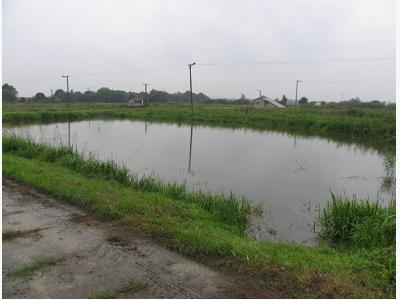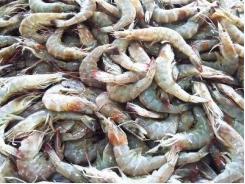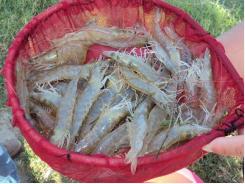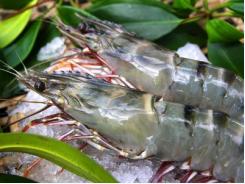The inevitable pH fluctuations of aquaculture pond water

Common measurement a misunderstood water quality variable
The levels of pH in aquaculture ponds are affected by such factors as time of day, mechanical aeration, vegetation and others. Photo by Darryl Jory.
Aside from temperature and dissolved oxygen, pH is likely the most commonly measured water quality variable in aquaculture. But it is probably the most misunderstood water quality variable in aquaculture. One of the most disconcerting aspects of pH in aquaculture systems is its propensity to change rapidly. Thus, I would like to convince you that this is a natural phenomenon and often of little consequence.
What is pH?
I would feel remiss not to define pH despite it divulging into basic chemistry. The pH was adopted many years ago so that chemists would not have to express the hydrogen ion conductivity in a solution as a small molar number, e.g., 0.00000001 M hydrogen ion concentration. The pH is defined as the negative, base 10 logarithm of the hydrogen ion concentration. That is:
pH = -log[H+]
Thus, a hydrogen ion concentration of 0.00000001 mole/L (10-8 M) becomes pH 8:
pH = -log(10-8 M) = -log (-8) = 8.
Pure water has a hydrogen ion concentration of 10-7 mole/L (pH 7). The product of hydrogen ion and hydroxyl (OH–) ion concentration in pure water must equal 10-14 at 20 degrees-C. This is a basic characteristic of water. Thus, pH ranges roughly from 1 to 14, and pH 7 – where hydrogen ion and hydroxyl ion concentration are equal – is the neutral point (neither acidic or alkaline). The farther below pH 7, the more acidic, while the farther above pH 7, the more basic (or alkaline) the water will be.
Relevance and behavior in aquaculture systems
Aquaculture species will usually die quickly if the pH is less than 4 or greater than 11 (Table 1). Most species can tolerate a pH between 6 and 9 fairly well, but they are usually stressed by pH outside this range resulting in less growth and greater susceptibility to disease. The optimum pH for most species is between 7 and 8.5. However, brief excursions outside the optimum range likely are insignificant.
Boyd, pH, Table 1
| pH | Effect |
| 4 | Acid death point |
| 4-5 | No reproduction |
| 5-6 | Slow growth |
| 6-9 | Best growth |
| 9-11 | Slow growth |
| 11 | Alkaline death point |
The effect of pH on pond fish and crustaceans
The ambient pH of water that does not have a high abundance of biological activity (high rates of respiration or photosynthesis) is determined by its chemical composition. Some common examples of ambient pH are provided in Table 2 below.
Boyd, pH, Table 2
| Type of water | pH range |
| Water exposed to highly acid-sulfate soils | 2 to 5 |
| Water from jungle areas that contain a high concentration of organic acids | 4 to 6 |
| Water in humid areas with highly leached soils | 5.5 to 7 |
| Water in humid areas with limestone | 7 to 8 |
| Water in arid regions | 8 to 9.5 |
| Seawater | 7.9 to 8.2 |
Examples of ambient pH values
As a general rule, the ambient pH tends to increase from around 5 in water with no alkalinity to 8 or above at alkalinity of 100 mg/L or greater.
Acidic waters are typical limed in aquaculture, and the ambient pH after liming usually is 7 to 8. However, the pH fluctuates in aquaculture ponds, often rising from 6 to 7 in the early morning to 9 to 10 in the afternoon in ponds with low alkalinity (0-40 mg/L), and from 7 to 8 in the morning to 8 to 9.5 in the afternoon in ponds that have naturally higher alkalinity or have been limed. This phenomenon is illustrated in Fig. 1 with pH data from two ponds of different alkalinity.
Carbon dioxide exists in water up to pH 8.3. Aquaculture ponds have a high abundance of phytoplankton and other microorganisms because of additions of nutrients in fertilizers and feeds. Thus, there is a lot of respiration at all times, and a high rate of photosynthesis during the daylight hours. The carbon dioxide concentration is greatest in the early morning, but during the day the phytoplankton remove carbon dioxide (an acidic substance), and the pH rises.

Fig. 1: Daily fluctuation in pH in a pond with low alkalinity (dashed line) and a pond with moderate alkalinity (solid line).
When all of the carbon dioxide has been removed, the pH will be 8.3. Photosynthesis continues, because most phytoplankton can use bicarbonate as a carbon source in photosynthesis. However, when carbon dioxide is derived from bicarbonate, carbonate is released into the water. It hydrolyzes and results in the release of hydroxyl ions that cause pH to rise further.
Alkalinity tends to buffer water against pH change and calcium in the water precipitates carbonate as calcium carbonate. Thus, the pH rise in water is lessened by the presence of a moderate to high alkalinity concentration and plenty of calcium. However, low alkalinity and low calcium concentration and higher alkalinity waters with low calcium concentration may reach pH of 10 or above in the afternoon because of photosynthesis.

Dense plant growth and phytoplankton blooms can cause pH to remain high, even at night. Photo by Darryl Jory.
At night, photosynthesis stops, and carbon dioxide accumulates in the water causing basically the reverse of the reactions that occurred during the day. The pH declines to about the same morning value of the previous day.
Managing daily fluctuations
There is little that can be done to avoid the daily fluctuation in pH. The difference between minimum and maximum daily pH values, however, can be minimized by using fertilization and feeding rates that do not result in excessive phytoplankton, liming low alkalinity ponds, and applying a soluble calcium source such as gypsum (calcium sulfate) to ponds with moderate to high alkalinity but low calcium concentration. As a general rule, calcium concentration expressed as milligrams per liter of calcium carbonate (calcium concentration X 2.5) should be approximately equal or greater than the total alkalinity.
The wide fluctuation in pH that occurs daily in ponds even with moderate to high concentrations of alkalinity and calcium seem to be very disturbing to many aquaculturists. In fact, shrimp farmers may add liming materials to ponds in an effort to stabilize pH around 8. This is a futile effort; ponds filled with seawater or brackishwater often are near saturation with calcium carbonate, and liming materials do not dissolve. The normal daily fluctuation in a pond within the optimal range of alkalinity and calcium concentration will not harm fish, shrimp, or other aquatic organisms.
My advice is as follows: if you measure the pH in a pond and find it between 8.5 and 9.5 in the afternoon, do not worry, in a few hours, the pH will be lower and the culture species will not know the difference.

Aquaculture ponds with acidic waters are typical limed as part of a regular management protocol. Photo by Darryl Jory.
Ponds with low alkalinity water – below 40 mg/L in freshwater, 65-75 mg/L in brackishwater, and 90-100 mg/L in seawater – agricultural limestone or lime should be applied. Sodium bicarbonate can be used where it is necessary to quickly increase alkalinity.
Related news
Tools

Phối trộn thức ăn chăn nuôi

Pha dung dịch thủy canh

Định mức cho tôm ăn

Phối trộn phân bón NPK

Xác định tỷ lệ tôm sống

Chuyển đổi đơn vị phân bón

Xác định công suất sục khí

Chuyển đổi đơn vị tôm

Tính diện tích nhà kính

Tính thể tích ao




 Brazil study results encouraging for injector
Brazil study results encouraging for injector  Efficiency of mechanical aeration
Efficiency of mechanical aeration